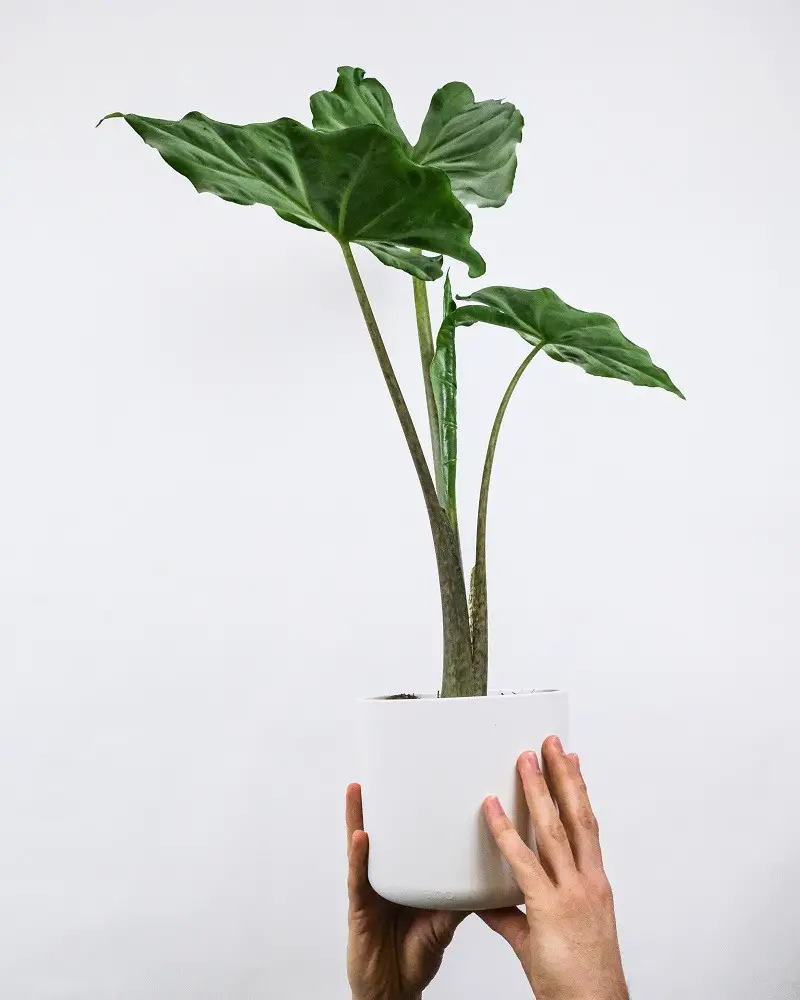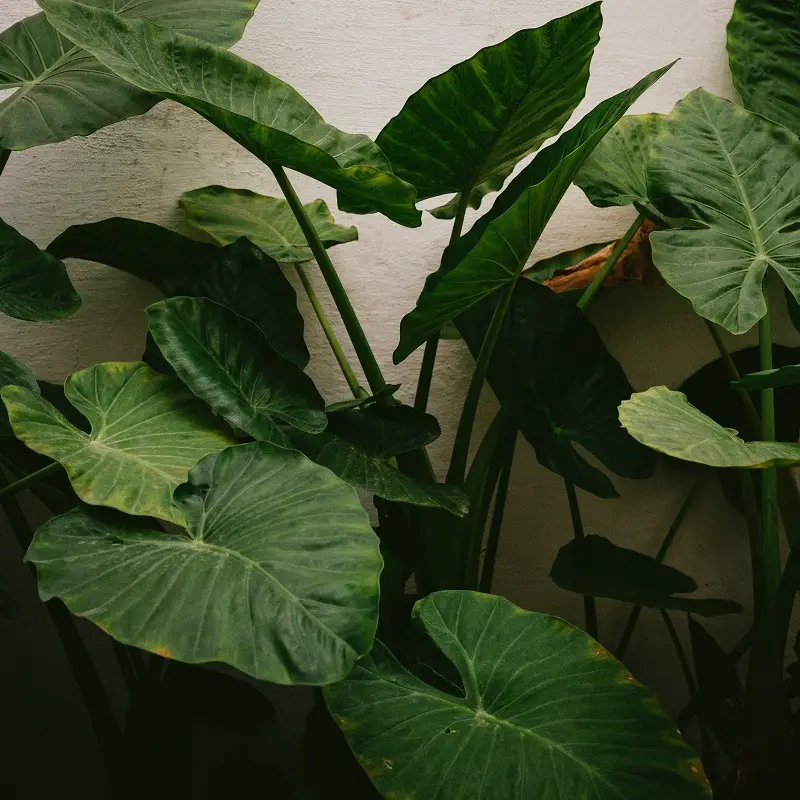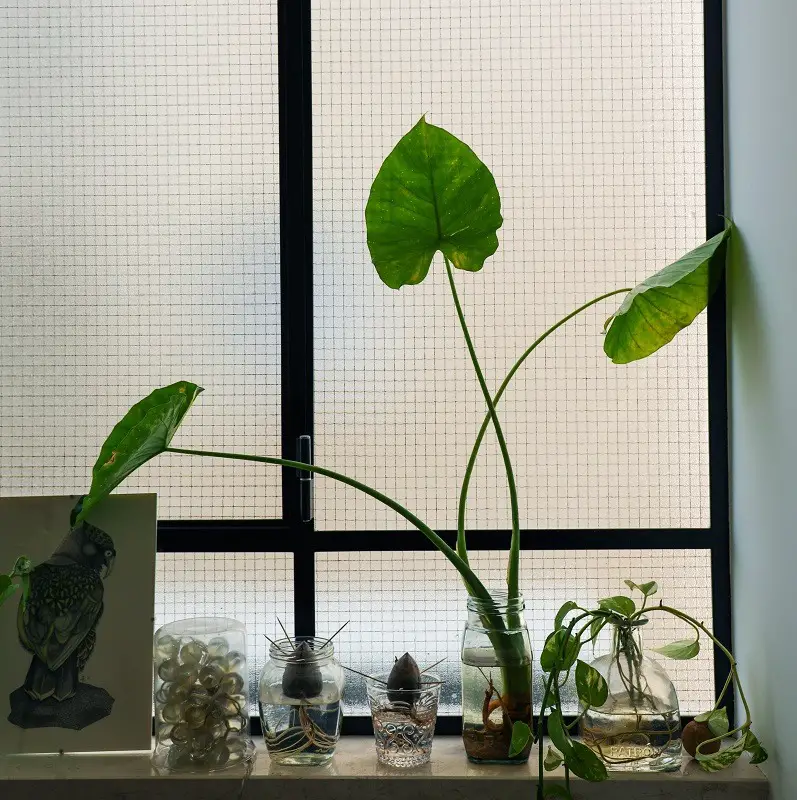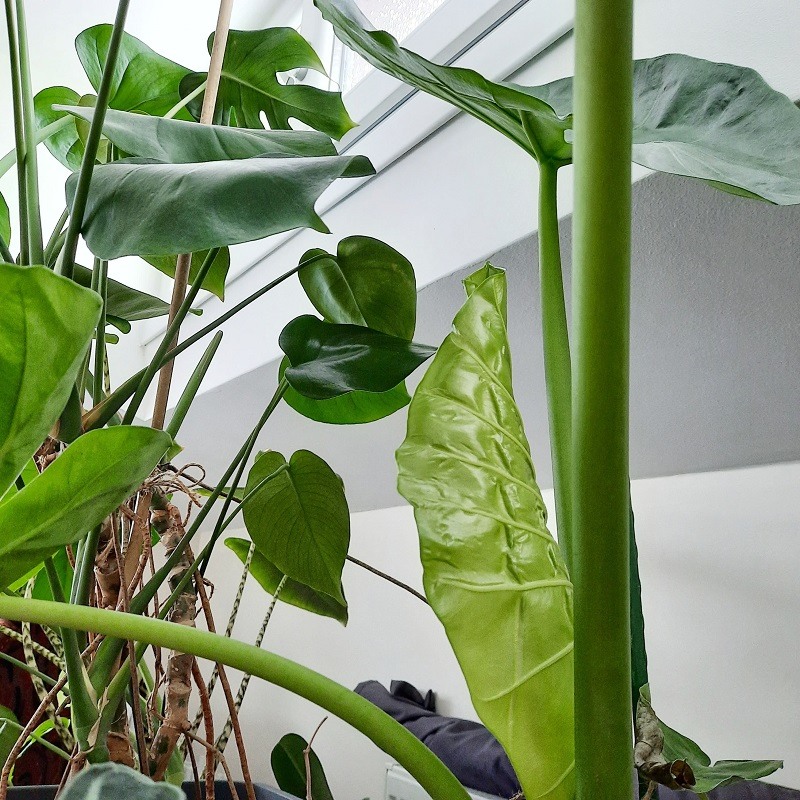Ever wondered why your Alocasia Polly Leaves are turning yellow? Let’s find that out together in this article.
An Alocasia Polly is an excellent indoor plant to consider. But the plant is a bit temperamental. The houseplant requires a higher maintenance level to enhance successful growth. Yellowing of leaves is something inevitable despite putting in the best effort.
The most common cause of elephant ear leaves turning yellow is overwatering. Other geneses are low light, lack of warmth, low humidity, nutritional deficiencies, pest infestations, and diseases.
It would be best to take immediate action to bounce back the plant. You can use the easy solutions in the article to revive your plant.
You May Also Like: Why Are My Alocasia Leaves Curling?

You May Also Like: Why Is My Alocasia Zebrina Drooping?
Causes of Alocasia Polly Leaves Turning Yellow and Solutions
Older Foliage
Alocasia plants keep on producing new growth in their life cycle. The new growth usually comes along with the yellowing of older leaves at the bottom of the plant.
There is no need to freak since this is a natural process. Normal aging shut down old leaves and drain all the resources. It is the reason behind the yellowing of leaves.
It would be best to note that the yellowing of leaves due to aging is inevitable. The natural process will happen despite providing the right light and the correct amount of water.
The houseplant usually sends energy to the new growth. It will take few days for the plant foliage coloration to get restored.
Do not waste time trying to dig out tactics for reviving the old foliage. The new and healthy foliage is an indicator of being on the right track.
Insufficient Lighting
Alocasia plants thrive in an area receiving bright indirect sunlight. Besides that, the houseplant can tolerate medium lighting. Lighting is a less common cause of elephant ear leaves turning yellow.
The tropical plant grows under the canopy in their natural habitat. The brightness of sunlight under the forest shade is better when compared to indoor conditions.
Consider protecting your elephant ear leaves from harsh indirect sunlight. But seasonal changes happen to be the reasons behind the yellowing of leaves.
Sunlight usually starts to fade during autumn and partially disappears in winter. The period makes the green elephant ear leaves begin fading or turning yellow.
We recommend installing grow light to save the plant from turning yellow. You can also move the houseplant to a location where there is moderate light.
Keep in mind that the yellowing of leaves can also be a sign of over-exposure to sunlight. The heat from the sun will scorch and bleach the leaves.
You Might Also Like: How to Care for Alocasia Amazonica Plant
Overwatering
Yellowing of leaves is the classic sign of overwatering. It would be best to immediately check the moisture content and try to review your watering schedule.
Alocasia Polly plants thrive in moist soil. It is the reason why many growers end up overwatering the houseplant.
We recommend checking the root system to confirm the presence of the root-rot disease. The condition is usually characterized by brown, squishy, and foul-smelling.
It would be best to cut off the affected parts and repot the plant. Use a container will drainage holes at the bottom and proper drainage potting mix. Formulate a watering regime to avoid overwatering.
Maintain a regular watering schedule to prevent the soil from drying. Any form of inconsistent might result in either overwatering or underwatering.
You May Also Like: Peperomia Plant Care Guide
Water Quality
Alocasia Polly plants are sensitive to minerals. These houseplants usually display their unhappiness on the leaves.
Mineral or contaminated water causes Alocasia Polly yellow spots. Besides that, the leaves usually showcase spotting and brown tips.
It would be best to consider using filtered or distilled water. The water type has few minerals that are less likely to affect your houseplant.
We recommend adding few drops of dechlorinating in tape water and rainwater. It helps to neutralize chemicals causing the yellowing of leaves.
Research shows that low-quality water contains several minerals and chemicals that cause leaves discoloration. Switching to filtered or purified water happens to be the best option for watering the plants.
Soil Type
Alocasia Polly soil plays a critical role in watering. It would be best to consider high drainage soil to prevent waterlogging issues.
Excess soil moisture due to waterlogging causes the yellowing of alocasia leaves. The problem occurs due to a damaged root system as a result of root rot.
We recommend adding peat in the potting mix to improve soil water holding capacity. Besides that, consider a container with drainage holes to help in getting rid of excess water.
Preventing waterlogs and excess soil moisture help to resolve the yellowing of alocasia leaves.
You Can Also Read: Why Is My Alocasia Polly Dying?

Temperature Stress
Lack of warmth makes alocasia leaves start turning yellow. Research shows that the houseplant is warmth-loving. The alocasia Polly thrives in a temperature range of 65oF to 85oF (18oC to 29oC)
Keep in mind that the houseplant is intolerant to frost and tends to suffer more when the temperature falls below 55ºF (13ºC).
If you notice your alocasia leaves turning yellow during winter, it is a clear indicator the warmth is not enough for their survival.
Temperature fluctuation is inevitable. The best option is to consider placing heat pads around the roots to make them warmer than the room temperature.
Low Humidity
Alocasia Polly flourishes in an environment with high humidity. The most exciting thing is that this tropical plant can still grow under a low humidity level.
The houseplant grows best at a humidity level above 60%. The yellowing of leaves and brown tips is an indicator of low humidity.
It would be best to note that the leaf’s discoloration occurs when the humidity level is below 50%. But there are few instances where alocasia Polly will thrive at 50% humidity level.
Growing alocasia with other tropical plants will help to elevate the humidity level. If your houseplant is coping with low humidity, it would be best to consider watering regularly.
You can also install a humidifier in the house to help in elevating the humidity level. Find out more information on how to increase the humidity level for your houseplants.
You May Also Like: Why Are My Philodendron Leaves Curling?
Nutritional Deficiencies
Lack of sufficient nutrients in the soil will result in the yellowing of alocasia leaves. Research shows that alocasia plants in an area with adequate nutrients.
Low nutrients usually accelerate the retirement of leaves. We all know that old leaves have yellow coloration. The plant undertakes the measure to salvage the nutritional resources.
Do not freak if you notice the yellowing of leaves is due to nutritional deficiencies. Apply fertilizer to the potting mix gradually to avoid shocking the plant.
Design a feeding plan and keep on increasing the amount of fertilizer. Monitor the plant foliage to spot any signs of change. We recommend using liquid fertilizer that permeates the soil and root ball.
Over-Fertilization
Alocasia Polly is a heavy feeder. The chances of over-feeding the houseplant are high. The issue will result in the browning of foliage tips and edges.
Sometimes the toxified soil usually causes yellow leaves. It would be best to correct the problem since the roots can get damaged and the plant dies in the long run.
Changing the feeding schedule and avoiding fertilizer for the houseplant in winter is commendable. It will help to prevent the excessive accumulation of salt minerals in the soil.
You can water the potting mix to enhance the leaching of buildup salt. Allow the excess water to drain through the drainage holes. It will help to prevent the buildup of excess soil moisture.
You May Also Read: Why Are My Alocasia Leaves Turning Brown?
Pest Infestation
Alocasia leaves are highly susceptible to pests like aphids, mealybugs, thrips, scale, and spider mites. These creatures such cell sap and other nutrients from the leaves.
The nutritional withdrawal by pests results in the yellowing of leaves. You will also notice some white spots on the surface of the leaves.
The best option is isolating the plant to prevent the spread of pests to other indoor plants. Use insecticidal soap to wash the alocasia leaves.
You can also use an alcohol-based solution to rub on the surfaces of the leaves. The solution will help to eliminate bugs and other stubborn pests on the leaves.

Plant Diseases
Root-rot is the most common disease afflicting alocasia plants. The disease develops due to overwatering the houseplant.
The damaged roots usually have foul-smell and brown patches. It would be best to sterilize the shears and cut off the rotten roots.
Remember to repot the plant to a new container and use a fresh potting mix. Transplant the plant and discard the cut roots away from other houseplants.
Come up with a proper watering schedule to prevent overwatering and underwatering. The plant will experience some stress after the transplant. But these issues will last for a few days.
Acclimatization and Dormancy
Alocasia plants usually need time to acclimate to environmental and weather changes. Keep in mind that an abrupt change in lighting could also trigger dormancy.
Both acclimatization and dormancy will cause the yellowing of leaves. The best option to consider is to avoid moving the plant from one place to another more often.
You should note that dormant alocasia will develop new growths after a few weeks. But keep the houseplant in a location that has favorable conditions.
You May Also Like: Why Are My Monstera Leaves Drooping?
Related Questions
Why Is My Alocasia Plant Dying?
Alocasia Polly leaves dying is due to underwatering, overwatering, exposure to direct sunlight, and diseases. The yellowing of leaves is a prominent sign of a dying alocasia plant.
Do I Cut Off Yellow Leaves?
Absolutely. But it would be best to wait for the leaves to turn yellow and die. Most yellow leaves on alocasia plants usually fall off after a few days.
Can Yellow Leaves Turn Green Again?
Not really. Most yellow leaves usually die and fall off from the main plant. It would be best to inspect and identify the root cause of the problem. Fixing the issue will prevent further alocasia Polly leaves from turning yellow.
Does Alocasia Need Sun?
Alocasia is a tropical and subtropical plant that thrives in a warm environment. The plants require bright indirect sunlight to enhance their survival. Low lighting will foster yellowing and legging of stems.
How Do You Fertilize Alocasia?
Alocasia Polly plants are heavy feeders. It is advisable to fertilize the plant twice in summer and spring to enhance better growth. Do not fertilize the plant in winter since the houseplant becomes dormant during the cold season. The buildup of excess minerals toxifies the soil.
How Fast Does Alocasia Grow?
Alocasia Polly plants are among the fastest-growing houseplants. The plants can grow and reach a maturity of 3-4 feet. However, the plant does not tolerate harsh winter.
Why Are My Alocasia Leaves Curling?
Overwatering is the main cause of alocasia leaves curling. It would be best to develop a watering schedule to prevent waterlogs in the pot. Always test the moisture content of the soil before watering the plant.
Can Alocasia Live Indoors?
Absolutely. Alocasia Polly plants are sensitive to lighting. Exposing the plant to direct bright sunlight will cause scorching and browning of leaf edges or tips. It is advisable to grow the plant under bright indirect sunlight like that of their natural habitat.
Are Yellow Leaves A Sign of Overwatering?
Overwatering and underwatering are the common culprits for causing yellow leaves in plants. Excess moisture in the soil cause root rot and this inhibits the intake of vital nutrients.
How Do You Save A Dying Elephant Ear Plant?
Elephant ear leaves are evergreen in all seasons. But this is applicable when the right condition is provided to the plant. The best way of reviving the plant is ensuring the surroundings have a higher humidity and moderate temperature. Besides that, water the plant adequately and provide the necessary nutrients.
How Often Should You Water Elephant Ears?
Use containers with drainage holes at the bottom to prevent waterlogging. We recommend watering the plant daily during summer. But remember to test the moisture content level before watering. It is the best option of avoiding overwatering.
You May Also Enjoy: Hibiscus vs Roselle

In Conclusion
Once the Alocasia Polly leaves begin to turn yellow, there is no chance for them to regain their green coloration. The best option is to focus on the cause and identify methods of fixing the issues.
Common causes of alocasia leaves turning yellow are overwatering, low humidity, nutritional deficiencies, lack of warmth, and direct sunlight exposure.
Providing the right condition will foster the proper growth of your alocasia Polly plant. There will be no need to worry about the yellowing and browning of plant foliage.
You May Also Read: Why Are My Rhaphidophora Leaves Curling?
More Sources and References
- Editor. Elephant Ears Plant Care. University of Florida.
- Susan Mahr. Alocasia Plant Care. University of Wisconsin.
- David H. Trinklein. Lighting Indoor Houseplants. University of Missouri.
